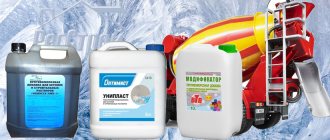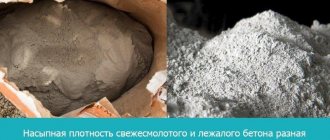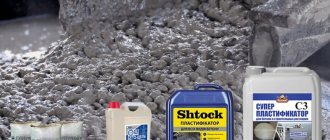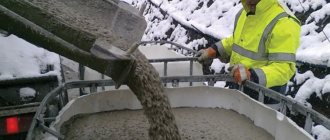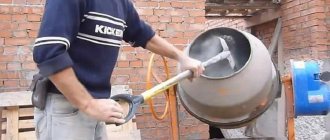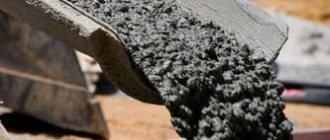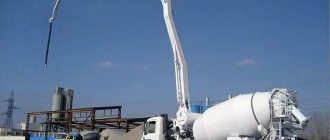To dry the concrete mixture, a mandatory factor is high temperature, the optimal value is 10-25°C. If you work with cement outside in winter, the moisture will crystallize and the solution will be hopelessly destroyed. An anti-frost additive (AMD) in concrete will help to pour concrete even in winter. The assortment includes compositions with varying resistance to sub-zero temperatures; some types allow construction to continue at -30°C. Antifreeze additives prevent the mixture from freezing.
What is concrete with antifreeze additives?
Concrete additives contain special additives or their complexes that combine with water and lower the temperature at which moisture transforms into another form. Another function of PMD in concrete is to accelerate setting; the process of strength gain depends on temperature; in cold weather one would have to wait 2 months or more. Concrete with PMD has an accelerated kinetic reaction.
The standards do not establish separate requirements for the quality of additives; the standards apply the same as for other compositions in accordance with GOST 21411-2008. To protect metal elements in concrete, special additives are used, which are regulated by GOST 31384-2008.
An antifreeze additive is a substance that lowers the freezing point of water in the substances to which the additive is added
Advantages
Cement mortars benefit from an antifreeze additive due to a number of advantages:
- the possibility of construction without downtime during the winter season;
- ease of transportation of the liquid composition at low temperatures;
- reducing the need to heat concrete to set the mixture;
- increasing the strength of the concrete structure;
- reducing the consumption of cement mortar in comparison with the standard composition.
Flaws
Disadvantages of PMD:
- lead to the formation of salt stains on top of the material, they are extremely difficult to remove;
- The strength of the material is significantly reduced if the preparation technology is violated: add an excessive or insufficient amount of anti-freeze additive to the concrete or ignore caring for it until it sets;
- Some components are toxic and unsuitable for use in residential areas.
Special Requirements
The manufacturing company stipulates how the antifreeze additive is introduced into the concrete. Compliance with the recommendations of additive manufacturers allows you to ensure the required performance characteristics of the concrete mass.
Ensuring the desired effect when introducing modifiers is achieved by observing the concentration of additives specified by the manufacturer. Violation of the recommended percentage when adding ingredients disrupts the normal course of the hydration process and leads to freezing of the solution.
Compliance with the formulation of modifying components helps to increase strength, increases the density of the composition, has a positive effect on water resistance and protects steel reinforcement from the negative effects of corrosion processes.
Ensuring safety precautions when introducing antifreeze plasticizers is an important point. Potash and sodium nitrates introduced into concrete solution have a negative effect on human health. When mixing, it is important to protect the mucous membrane of the eyes and skin from toxic components.
Use protective overalls, goggles and gloves when performing work on introducing frost-resistant ingredients yourself.
Kinds
Each antifreeze additive for concrete affects the physical and chemical properties of the solution in a different way.
This property allows concrete and various mixtures to harden at temperatures below zero.
Modern compounds are manufactured taking into account one of three mechanisms:
- antifreeze. Reduces the freezing point of water. Helps normalize the curing process;
- setting accelerators. Reduces the time before mineralization and acquisition of maximum strength of the composition;
- solvents. They help dissolve concrete particles in water that were initially resistant to dissolution. According to the final result, the group is comparable to the effect of antifreeze, but has less negative impact on the strength of concrete stone.
The most commonly used antifreeze additives in concrete are from the group of setting accelerators and antifreezes. PMD contains salts of inorganic (nitrates, carbonates, chlorides, sulfates, formates) and organic (urea) origin. Some of the most common materials are calcium chloride and ammonia water.
The listed groups are further divided into subgroups. Without knowing their properties it is impossible to make the right choice.
Plasticizers
Antifreeze plasticizers are based on melamine resin and naphthalene sulfates, as well as organic polyacrylates. They have a plasticizing effect on concrete, reduce water consumption, increase the strength of the structure and make it waterproof.
The plasticizer not only makes concrete frost-resistant, but also gives it plasticity
After using an anti-frost additive, concrete is easier to lay and level. It is easier to fill any form with the mixture and remove voids from it. Cement retains moisture longer. PMDs reduce energy and water costs.
Strengthening
Used to accelerate the hardening of concrete. The composition contains aluminum and iron sulfates, calcium nitrate and calcium chloride. Their main task is to reduce the hardening time of the solution. They act during the first 3 days, at this time the concentration of the antifreeze additive is highest and it is more effective. After adding strengthening additives, work with the finished cement mortar can be carried out taking into account the increase in class strength.
Corrosion resistant
Antifreeze, corrosion-resistant additives are used to protect reinforced concrete structures from frost and oxidation. They have a positive effect on the service life of the product, improving durability. With such additives, concrete is more resistant to aggressive substances.
Mobility regulators
In warm air conditions at a construction site, the cement mortar sets quickly, and substances of this group prolong the possibility of using the mixture.
Recently, the demand for building additives has increased significantly, and additives with a wide range of actions are now available in this area
They are chemical additives and come in two types:
- Additives that are introduced into the mixture in small quantities (0.1–2% by weight of cement) and regulate the properties of concrete.
- Finely ground ligatures (5–20%) are used to reduce cement consumption without changing the quality of products.
Frost-resistant
Frost-resistant additives are antifreezes that allow construction work to be carried out at negative thermometer values.
You can determine the composition of the product by labeling:
- NC – calcium nitrate;
- M – urea;
- M NK – compound of previous substances;
- P – calcium carbonate, reduces the hardening time of the composition at -30°C;
- CA is a mixture of calcium and hydrochloric acid. Not used for reinforced concrete structures, as it accelerates metal corrosion.
Complex
Construction of houses, baths, saunas and swimming pools in the cold season requires several of the listed effects simultaneously. Complex additives accelerate the hardening of concrete and cement mortars, strengthen reinforced concrete structures and protect the metal from destruction.
When used correctly, builders get the expected results.
Types of antifreeze mixtures
Antifreeze additives reduce the temperature at which water turns to ice. They are present in the following types of concrete solutions:
- Self-prepared with the introduction of special frost-resistant additives and plasticizers.
Preparing a frost-resistant composition on your own requires following the manufacturer’s recommendations, which take into account the brand of cement, ambient temperature and the percentage concentration of the substances introduced. After the additive has been introduced into the solution, it is necessary to wait a certain time to ensure its even distribution - Industrially produced ready-made mixtures, the use of which guarantees the quality of work performed, eliminates the possibility of errors associated with the compatibility of ingredients and the selection of the optimal recipe.
The following antifreeze additives are used:
- potash, which accelerates the process of setting and hardening at temperatures down to -30 ° C, and also prevents corrosion of reinforcement;
- sodium nitrate and urea, allowing the use of concrete at temperatures down to -15 ° C.
Simultaneously with the additives, plasticizers are introduced into the concrete to increase the plasticity of the mixture. According to the specifics of construction work, the percentage of plasticizing components changes:
- When performing concrete work, the share of plasticizers is increased to 15%.
- When constructing walls using the masonry method, the content of ingredients does not exceed 10%.
Antifreeze additive protects concrete from exposure to cold at temperatures down to -20°C, accelerates the hardening of concrete, slows down the hydration process and inhibits the release of heat from concrete
Industrially produced dry mixtures containing antifreeze additives are convenient to use for:
- plastering and finishing works;
- masonry walls.
How is concreting done?
Initially, it is worth choosing the right PMD. There are compositions of their own preparation that have a similar effect to production means. One of the simple and universal antifreeze additives is ammonia water. The substance is characterized by low cost and no effect on the wall frame.
Its concentration is determined depending on the ambient temperature:
| Air temperature, °C | Concentration of ammonia mixing water, 5% |
| < -10 | 5 |
| from -10 to -20 | 10 |
| from -20 to -35 | 15 |
| < -35 | 20 |
Any compositions are added to a heated (10-20°C) or cold solution. It is worth choosing a method of adding, taking into account the technical means of implementation and the goal.
Antifreeze additives in concrete accelerate setting; they reduce the time from production to the initial setting stage by 3 hours. There is enough time to transport the train over distances of up to 100 km. It is unlikely that it will be possible to deliver the solution to remote objects.
They are used for monolithic, reinforced concrete and concrete structures
To improve the mobility of the composition and its homogeneity, heating systems can be built into the tanks of cement tankers.
The procedure for pouring concrete is carried out in standard formwork, which does not differ from traditional practice. Changes may occur during the maintenance stage of the composition, but the procedure depends on the type of PMD. Some manufacturers and types require insulation of the surface of the solution by covering it with a layer of sawdust or plastic film. The temperature inside the concrete increases due to the retention of internal heat.
Insulation is required when adding a low concentration of PMD. If the proportion of additives is relatively high, hardening occurs without additional insulation and heating, but subject to the ambient temperature.
ANTI-FROST ADDITIVE “STANDARD PMD” with a plasticizing effect
ANTI-FROST ADDITIVE “STANDARD PMD-20” with a plasticizing effect
Description
"STANDARD PMD -20" refers to antifreeze additives and is recommended for
for use in concrete work under conditions of low ambient temperatures (down to -20° C). "STANDARD PMD -20" is a multi-component balanced complex that is used for all types of work using the winter concreting method. Due to the presence of a plasticizing component in the composition, “STANDARD PMD-20” significantly improves the plasticity of the concrete mixture, which makes it possible to transport mortars and concrete mixtures over long distances and place them in formwork for subsequent hardening. Provides a standard set of concrete strengths during work in winter conditions and during the production of prefabricated concrete and reinforced concrete structures and mortars for various purposes in accordance with GOST 24211-03.
The use of "STANDARD PMD -20" in winter conditions allows:
- ensure a smooth increase in strength without sudden setting
- increase the water resistance of concrete during subsequent hardening;
- increase the mobility of concrete mixtures at subzero temperatures;
- increase the frost resistance of concrete products and improve the structure of concrete;
- increase the protective properties of concrete in relation to steel reinforcement;
- significantly expand the time range of construction work using concreting without increasing heat and electricity costs;
- accelerates and facilitates the heating of concrete during heat treatment due to increased heat release during accelerated hydration of cement;
- allows you to “reanimate” stale cements.
In this case, it is especially effective for stale high-grade cements; in climatic conditions where the ambient temperature does not fall below minus 10°C, the use of the additive allows all types of concreting work to be carried out without the use of additional measures to preserve or heat the concrete.
Additive dosage in % of cement weight depending on temperature:
Estimated concrete hardening temperature, °C Dosage “STANDARD PMD -20” by weight
cement, in%
0 -5 °C 1-1.5%
-5 -10 °C 1.5-2.5%
-10 -15 °C 2.5-4%
-15 -20 °C 4-6%
The additive “STANDARD PMD-20” is introduced into the concrete mixture or solution in the form of a pre-prepared aqueous solution of 10-20% concentration. To increase the rate of dissolution of the additive components, it is recommended to heat the water and stir during the dissolution process. When storing an aqueous solution of the additive at low temperatures, sediment may form. In this case, the solution must be warmed and mixed before use. When producing concrete products using the winter concreting method directly at the enterprise, the use of “STANDARD PMD -20” will reduce the water-cement ratio, which will lead to accelerated hardening of the product, improved concrete structure, increased frost resistance, and water resistance.
The effect of the supplement increases when used in combination with other
winter concreting methods (additional heating, insulation, etc.).
Scope of application "STANDARD PMD -20"
In reinforced concrete structures and products: reinforced concrete structures with non-stressed working reinforcement with a diameter of over 5 mm; structures, as well as joints without prestressed reinforcement of prefabricated monolithic structures, having reinforcement outlets or embedded parts with combined coatings (alkali-resistant paint and varnish and other alkali-resistant protective layers on the metal sublayer), as well as joints without embedded parts and design reinforcement; concrete and reinforced concrete structures intended for use in non-aggressive and aggressive water environments with constant immersion; in concrete products the additive “STANDARD PMD-20” is used without restrictions.
Restrictions
The use of “STANDARD PMD -20” is not allowed: in prestressed
structures, for embedding joints of prefabricated reinforced concrete structures; V
structures with reinforcement outlets or steel embedded parts without special protection (SNiP 3.04.01-85. Guidelines for the use of concrete with antifreeze additives, Moscow 1968).
Material requirements
Materials for the production of concrete and mortars must comply with the requirements of GOST 26633-91 and GOST 28013. For the preparation of concrete and mortars with antifreeze additives, it is recommended to use cements containing no more than 10% tricalcium aluminate in the clinker. When requirements for frost resistance of 100 or more are imposed on concrete, it is recommended to use cements containing tricalcium aluminate of no more than 6%.
When using “STANDARD PMD-20” together with electric heating, it must be borne in mind that the additive contains electrolytes, which, when introduced into concrete, significantly increase its electrical conductivity.
Transportation and storage
Transportation is carried out by any type of transport in accordance with the rules for the transportation of goods in accordance with GOST 14189. It is produced in powder form, packaging - polypropylene bags with a polyethylene liner of 20 kg. The shelf life of the dry complex additive is 1 year from the date of manufacture. The additive must be stored under conditions
preventing moisture from entering.
Fire hazard and toxicity
The complex powder additive “STANDARD PMD-20” is not explosive. The components of the additive, in terms of the degree of impact on the body, belong to hazard class 3 according to GOST 12.1.007. Personal protective equipment: petal respirator, goggles, rubber gloves, overalls in accordance with GOST 12.4.011. Fire extinguishing media: water. When entering the body through the respiratory system under normal conditions and the presence of ventilation, the complex additive “STANDARD PMD-20” does not pose a real danger of acute inhalation exposure. It is necessary to be careful not to get the additive into food, skin or eyes, since the additive is irritating. If the additive gets on your skin or eyes, rinse it off.
water.
Areas of use
The active use of anti-frost additives in concrete is required in regions with low temperatures: in winter throughout the entire area of Russia, in various periods of the year in the northern regions. PMDs are used when it is necessary to carry out repair work that requires the restoration of concrete structures: residential buildings, roads, runways, hydraulic structures.
PMD for concrete at positive temperatures in the range of 1-5°C helps improve the strength and uniformity of the monolithic slab.
They make laying concrete much easier, increase its strength, etc.
Modifier Properties
Let's look at the effect of introducing plasticizers into a concrete mixture and what properties the additives have:
- Provides resistance of the mixture to low temperatures.
- They make it difficult to crack a monolith subjected to prolonged freezing with numerous settling cycles.
- They contribute to the stability of the monolith against attempts by water to penetrate deep into the massif.
- Significantly increases the hardness of the composition.
- Reduce the hardening time of the solution.
- Reduces the exposure of steel reinforcement to chlorides, which cause corrosion.
Concrete with PMD can be prepared independently using modifiers that are offered on the building materials market. It is possible to order the delivery of pre-prepared concrete mortar intended for construction work at subzero temperatures.
The introduction of modifiers helps to improve the performance characteristics of the concrete mixture. Supplements provide:
- increased plasticity of the composition, reducing the need for water required during mixing;
- lowering the temperature threshold at which water becomes ice;
The antifreeze additive is introduced into the concrete solution along with water, preferably with the last third of the liquid
- preservation of the physical characteristics of the solution, which, having an increased density, hardens normally in winter conditions;
- uniform consistency of the mixture;
- increased adhesion to the reinforcing frame.
Along with additives, special modifiers can be introduced into the mixture to change individual properties of the solution. The operating instructions for antifreeze components regulate the specifics of the joint use of ingredients. An antifreeze additive in concrete reduces the temperature at which water turns into ice from 0 to -25 degrees Celsius.
Additive consumption
The consumption of PMD in concrete directly depends on the purpose of the material and the application rates laid down by the manufacturer or technical documents. Mostly antifreeze is added in a concentration of 10-15% of the total weight of the solution. With an increase in dosage, the composition may lose some of its strength characteristics, and sometimes completely collapse.
Hardening accelerators are used in lower concentrations - 3-5% of the proportion of cement. When choosing a cost-effective additive, you should pay attention to accelerator salts, namely sodium formate, its concentration is 2-4% of concrete.
Warming up the material
There are 2 main ways to maintain heat in anti-frost concrete:
- heating with electrical equipment. The procedure is justified only when carrying out large-scale construction work, since the specific heating costs increase as the volume of concrete decreases;
- insulation. To ensure the desired temperature, concrete is often coated with insulating material. It prevents moisture evaporation and reduces heat loss. To stop evaporation, it is beneficial to cover the concrete with plastic film. More effective thermal insulation is provided by a layer of sawdust or covering with dry boards.
Recommendations
Working with cement mortar is relatively simple, but has a number of pitfalls:
- If you need to drill a hole, it is important to choose the right tool and drill. The most effective procedure is diamond drilling of holes in concrete or using a pobedit drill;
- To create high-strength, loaded structures, a metal frame must be laid. It is important to understand how reinforcement works in concrete in order to create the strongest possible structure. The best technical characteristics are provided by the reinforcement cage and fiber for concrete;
- The decorative qualities of cement are quite low; most often it is treated with a topcoat. There is an alternative option - grinding, it helps to eliminate protrusions and improve the appearance of the material. Several effective ways have been developed to polish concrete;
- the thermal insulation characteristics of any monolithic base are inferior to porous materials. Porous concrete blocks retain heat, create less load on the foundation and are easier to lay, but are not suitable for the construction of multi-story buildings.
